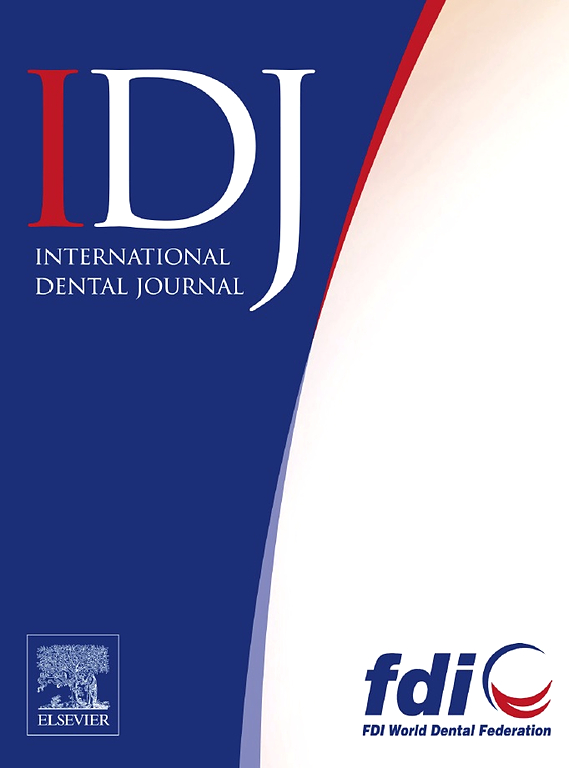海姆勒综合征伴有牙齿发育不全、牙釉质和牙本质矿化异常、牙根发育不良和PEX1突变
IF 3.2
3区 医学
Q1 DENTISTRY, ORAL SURGERY & MEDICINE
引用次数: 0
摘要
PEX1和PEX6基因的双等位基因变异与海姆勒综合征有关,海姆勒综合征的特征是淀粉性发育不全、感音神经性听力丧失、视网膜色素变性和指甲缺陷。本研究的目的是发现遗传变异和分析海姆勒综合征患者的牙齿。本文对1例海姆勒综合征患者及其父母进行了临床、影像学检查和全外显子组测序。对牙齿进行了扫描电子显微镜和微型计算机断层扫描。对Pex1进行免疫组化研究。建立突变蛋白模型。作者报告了一位患有海姆勒综合征的18岁男性患者,他携带一个复合杂合基因(C . 2966t >;C;p.Ile989Thr和c.2097_2098insT;PEX1基因p.i ile700tyrfster42)突变。临床表现为后恒牙釉质发育不全、轻度感音神经性听力丧失、视网膜色素变性、白甲。扫描电镜显示牙本质和牙釉质矿化异常。新发现包括爪指畸形、牙齿发育不全、小牙畸形、牙根发育不良、出牙失败等。p.i ile700tyrfster42变异预计会产生一种非活蛋白。p.Ile989Thr变异被预测破坏其与PEX6的相互作用。海姆勒综合征患者可能有蛛网膜畸形、牙齿发育不全、小牙症、牙齿发育迟缓、牙根发育不良、牙釉质和牙本质矿化异常以及牙出牙失败。本文章由计算机程序翻译,如有差异,请以英文原文为准。
Heimler Syndrome With Tooth Agenesis, Abnormal Enamel and Dentin Mineralization, Root Maldevelopment, and PEX1 Mutation
Biallelic variants in the PEX1 and PEX6 genes are implicated in Heimler syndrome, which is characterized by amelogenesis imperfecta, sensorineural hearing loss, retinitis pigmentosa, and nail defects. The objective of this study is to find the genetic variant and to analyze the teeth of a patient with Heimler syndrome. Clinical and radiographic examination and whole exome sequencing were performed on a Heimler syndrome patient and his parents. Scanning electron microscopy and micro-computed tomography were performed on a tooth. Immunohistochemical study of Pex1 was performed. Mutant protein models were made. The authors report an 18-year-old male with Heimler syndrome who carried a compound heterozygous (c.2966T>C; p.Ile989Thr and c.2097_2098insT; p.Ile700TyrfsTer42) mutation in the PEX1 gene. Clinical manifestations included amelogenesis imperfecta of the posterior permanent teeth, mild sensorineural hearing loss, retinitis pigmentosa, and leukonychia. SEM showed enamel and dentin dysmineralization. The newly findings include arachnodactyly, tooth agenesis, microdontia, root maldevelopment, and failure of tooth eruption. The p.Ile700TyrfsTer42 variant is predicted to produce a non-viable protein. The p.Ile989Thr variant is predicted to disrupt its interaction with PEX6. A patient with Heimler syndrome may have arachnodactyly, tooth agenesis, microdontia, delayed dental development, root maldevelopment, enamel and dentin dysmineralization, and failure of tooth eruption.
求助全文
通过发布文献求助,成功后即可免费获取论文全文。
去求助
来源期刊

International dental journal
医学-牙科与口腔外科
CiteScore
4.80
自引率
6.10%
发文量
159
审稿时长
63 days
期刊介绍:
The International Dental Journal features peer-reviewed, scientific articles relevant to international oral health issues, as well as practical, informative articles aimed at clinicians.
 求助内容:
求助内容: 应助结果提醒方式:
应助结果提醒方式:


